The AMD Llano Notebook Review: Competing in the Mobile Market
by Jarred Walton & Anand Lal Shimpi on June 14, 2011 12:01 AM ESTBattery Life: All Day Computing
AMD makes a point of their mobile offerings (A/C/E-series APUs) all offering “all day computing”, with a note that “all day” is defined as eight hours or more. While that’s easy to do with a gigantic battery, doing so with the typical 48/56Wh batteries in mainstream laptops is a lot more difficult. One of their test notebooks apparently manages around 10.5 hours (best-case) with a 62Wh battery, compared to 6.5 hours for a similar Core i5-2410M laptop. Without specifics on all the settings, we’ll just say that our results for “similar” laptops don’t show nearly the disparity AMD achieved, but the important point is that AMD is finally competitive in battery life.
We ran our usual series of battery life tests, with the LCDs set for ~100 nits (70% brightness for the Llano laptop). We shut off WiFi for the idle test and mute audio; the Internet test is run over WiFi and repeatedly loads four tabs of content every minute, again with audio muted; finally, the H.264 playback result is done with a set of earbuds connected and WiFi disabled. Here’s how the Llano laptop stacks up to some recently reviewed laptops—you can compare Llano with other laptops in Mobile Bench.
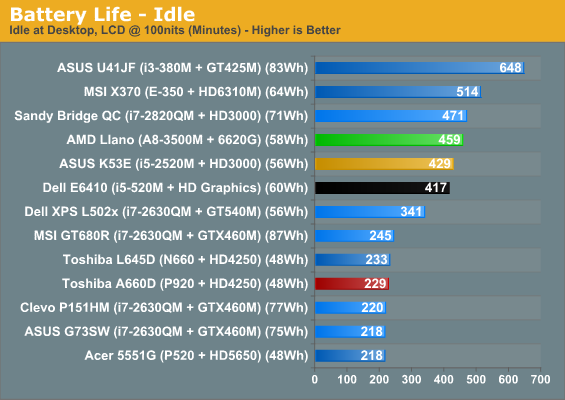

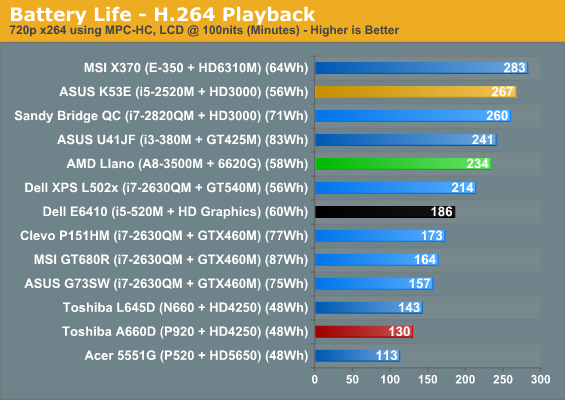
Starting with pure battery life, only three laptops consistently offer longer battery life than the Llano system: the ASUS U41JF, MSI’s X370, and the quad-core Sandy Bridge notebook. Also, the ASUS K53E boasts better battery life in the H.264 playback test, which for whatever reason is a test where SNB has proved particularly potent. Intel’s DXVA decode may be efficient, but it's also possible it's doing less work; we're running the test again with all of AMD's video enhancement features turned off. [Update: I retested with all the AMD video enhancement features disabled, and battery life didn't change, so Intel is simply more efficient at H.264 decoding with SNB.]
Back to the discussion of battery life: all three of the laptops that beat Llano have the advantage of slightly to moderately higher battery capacities, so the comparison isn’t entirely fair. Let’s level the playing field by looking at relative battery life.
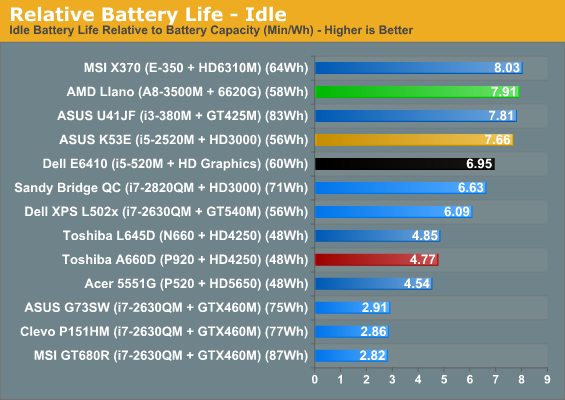
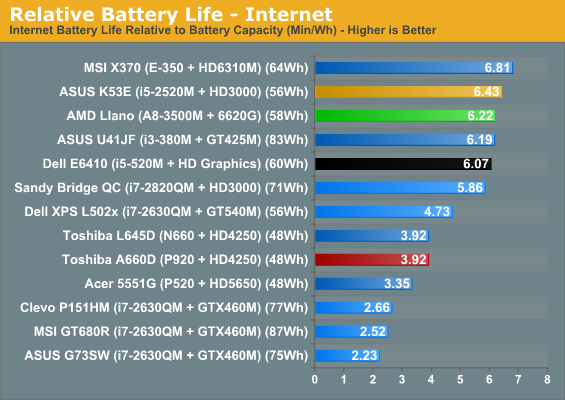
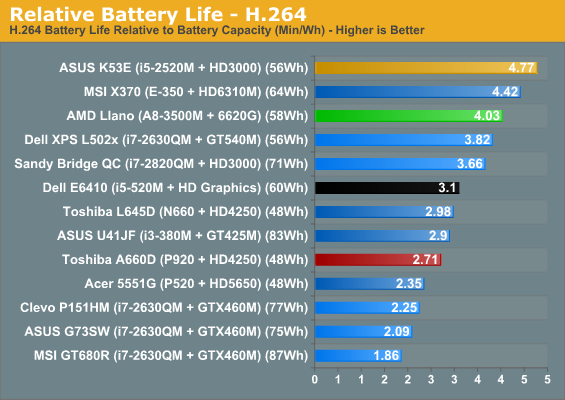
Rather amazing is that Llano actually rises to the top of the charts in the Idle test, and it’s only slightly behind the competition in the other two tests. Considering the X370 is equipped with an E-350 APU, the fact that Llano is even close is surprising. While we should note that the X370 wasn’t the most efficient of the E-350 laptops we’ve tested, we also need to point out that the 13.3” LCD is a lot closer to the 14” panel in the Llano notebook than the 11.6” panels used in the Sony YB and HP dm1z. The dual-core SNB notebook still leads in the H.264 test, and considering it has a 15.6” panel we’d say that relative battery life is very similar between the two.
We also want to talk about AMD’s claims of “all day battery life”. If we accept their definition of 8+ hours, the test laptop doesn’t actually hit that mark in our idle test. We did run the same test again at 40% LCD brightness (around 60 nits) and managed eight hours exactly, but that’s in an absolutely best-case test. For Internet surfing, which represents a more useful metric, the best way to get 8+ hours is demonstrated by ASUS’ U41JF: stuff in a higher capacity battery!
Rounding out the battery life discussion, we also tested battery life while looping 3DMark06 at native resolution (1366x768). This represents a reasonable 3D gaming scenario, and Llano still managed a reasonable 161 minutes. Considering graphics performance is a healthy step up from what Intel’s HD 3000 offers and that AMD manages double the battery life under gaming situations compared to the K53E, mobile gaming is clearly a win.
Overall, for the first time in a long time, AMD is able to offer battery life that competes with and even exceeds what Intel offers with their current mainstream offerings. There are of course a bunch of lower power Intel CPUs we could discuss, but looking at the 35W TDP parts the combination of 32nm and power gating has brought AMD back into the discussion. Even more interesting is that you should be able to get something like our test laptop for $600, possibly less, compared to dual-core SNB i5 laptops that start at $700. But then, perhaps Core i5 isn’t the best comparison for quad-core Llano, despite what AMD might like to say? Let’s move on to general performance and gaming discussions before we decide which mobile part is the “best”.










177 Comments
View All Comments
phantom505 - Tuesday, June 14, 2011 - link
I went with a K325 in a Toshiba with a Radeon IGP. Nobody I have lent it out to has every complained about it being slow or incapable of doing what they wanted/needed to. I get about 5 hours of battery life consistently. I don't do too much that is CPU intensive but I hear people moan and groan about the E-350 and Atom both when they try to open 50MB+ ppt files. I have no such problems.I for one an quite happy to see that AMD is still leading this segment since most users will be quite happy with AMD. I'm finding it more and more that Intel may own the top end, but nobody I know cares in the slightest.
mino - Tuesday, June 14, 2011 - link
E-350 is generally faster than K325 + IGP. Then than that, I fully agree.ash9 - Tuesday, June 14, 2011 - link
In this price range, I think not, besides Open(X) applications will reveal the potential - its up to the application developers nowGaMEChld - Tuesday, June 14, 2011 - link
My netbook is a pain to use precisely because of its graphics. It cannot properly play youtube or movie files fluently. Aside from its multi-media problems, I don't try to do ridiculous things on a netbook, so the other components are not much of a factor for me. But if I can't even watch videos properly, then it's trash.Luckily, I got that netbook for free, so I'm not that sad about it. I'll probably sell it on eBay and get a Brazos netbook at some point.
hvakrg - Tuesday, June 14, 2011 - link
Yes, they're becoming primary machines, but what exactly do you need the CPU part for in a primary machine today? Let's face it most people use their computer to browse the web, listen to music and watch videos, all of which are either relying on the GPU today or is clearly moving in that direction.Intel will have an advantage in the hardcore CPU market probably forever due to them being years ahead of the competition in manufacturing processes, but what advantage does that give them when it comes to selling computers to the end user? Things like battery life and GPU performance is what will be weighted in the future.
Broheim - Wednesday, June 15, 2011 - link
personally I need it to compile thousands of lines of code sometimes several times a day, if I were to settle for a E-350 I'd die of old age long before I get my masters in computer science.... some of us actually gives our 2600k @ 4.5ghz a run for it's money.th G in GPU doesn't stand for General... the GPU can only do a few highly specialized tasks, it's never going to replace and will always rely on the CPU. Unless you're a gamer you benifit much more from a fast CPU than a fast GPU, and even as a gamer you still need a good CPU.
don't believe me? take a E-350 and do all the things you listed, then strap a HD6990 onto it and try and see if you can tell the difference...
trust me, you can't.
ET - Wednesday, June 15, 2011 - link
Compiling code is a minority application, although I did that at a pinch on a 1.2GHz Pentium M, so the E-350 would do as well. Certainly won't use it for my main development machine, I agree.Still, as hvakrg said, most users do web browsing, listen to music, watch video. The E-350 would work well enough for that.
sinigami - Wednesday, June 15, 2011 - link
>most users do web>browsing, listen to music,
>watch video. The E-350
>would work well enough
>for that.
The Atom also works well enough for that, for less money.
You might be pleasantly surprised to find that current Atom netbooks can play 720p MKVs. For netbook level video, that's "well enough".
As you said, for anything tougher than that, i wouldn't use it for my "main machine" either.
ionave - Thursday, June 16, 2011 - link
Why would you spend $2000 for an intel powered laptop when you can build a desktop to do computations for a quarter of the price at 20x the speed, and get a laptop for $400 to run code on the desktop remotely and use it for lighter tasks? I'm surprised that you are a masters student in computer science, because your lack of logic doesn't reflect it. Correct me if I'm wrong, but why would you compute on the go when you can let the code on a desktop or cluster while the laptop is safely powered down in your backpack?Also, I can run Super Mario Galaxy using dolphin (CPU intensive) emulator at full frame rate on my AMD Phenom II X2 BE, and the cores in the A8 are improved versions of Phenom II X4. You really need to get your facts straight, since the CPU is actually VERY good. Go look at the benchmarks and do your research
Broheim - Thursday, June 16, 2011 - link
he clearly said primary machine, so before you go around insulting me I'd suggest you learn how to read.the 2600K is a desktop CPU you douchebucket, I never said my main machine was a laptop, quite to the contrary.
what you can and can't do is of no interrest to me, but first off, I never mentioned the A8 I said E-350, again with the failure to read.
nevertheless...
K10 is not even a match for Nehalem, and so far behind Sandy bridge it's ridiculous.
I've seen the benchmarks, I've done my research and concluded that the A8 CPU is far from "VERY" good, have you done yours?